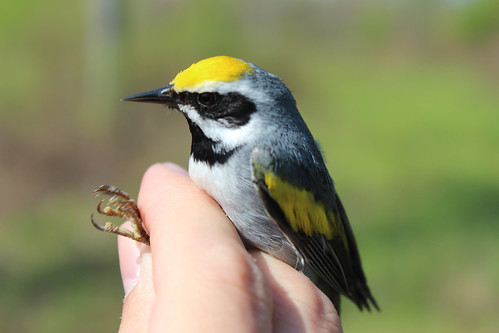
The golden-winged warbler has suffered a 66 percent population decline since the 1960s.
“Hear that?” Dr. Jeff Larkin bent his ears to a nearby cluster of trees amid a sea of briars.
“There’s one in there,” Larkin said excitedly. We were on the trail of a golden-winged warbler, a black-bibbed songbird, which winters in South and Central America and spends its springs and summers here in Appalachia where it breeds, nests and raises its young.
Larkin, professor of wildlife ecology and conservation at Indiana University of Pennsylvania and forest bird habitat coordinator for American Bird Conservancy, has tracked golden-winged warblers for years. And like many others, he has witnessed the bird’s population peril. The bird depends on the cover of early successional habitat to hide its ground nests. Early successional habitat, or young forests, have disappeared across the landscape as forests mature, timber harvest practices change, and disturbance events like fire are suppressed.
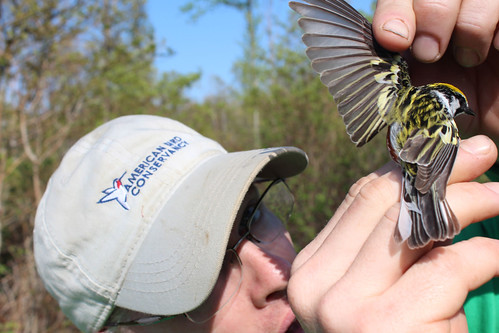
Dr. Jeff Larkin, Indiana University of Pennsylvania professor, checks this chestnut-side warbler for wing mites. Location: Centre County, PA. Credit: Justin Fritscher, NRCS.
Signs of Progress
But this day – here in the woods of Centre County, Pennsylvania – was a day of hope. Larkin and his team witnessed several females building nests on lands managed for early successional habitat.
“We’ve found that when the habitat is managed correctly, you’ll can attract high densities of nesting golden-winged warblers,” he said. The bird likes young forest habitat interspersed among large tracts of contiguous forest with variable age classes. This is important because when young leave the nest, they can transition to using a mix of older forests prior to migration.
Larkin and his partners are working with public land managers and with USDA’s Natural Resources Conservation Service (NRCS) and landowners to create high-quality golden-winged warbler nesting habitat using sustainable forestry practices.
“More than 80 percent of the bird’s nesting habitat in the Appalachians is on privately owned forests, which means the land management decisions by individual landowners is critical to the bird’s success,” he said.
Help for Private Landowners
NRCS provides landowners with technical and financial assistance to help them carry out sustainable forestry practices. Larkin and his team provide the scientific backbone to guide the development of conservation guidelines and to evaluate the bird’s response to conservation efforts. This past summer, his team has been out in the woods conducting bird surveys, banding adults, locating and monitoring nests, and capturing and banding fledglings.
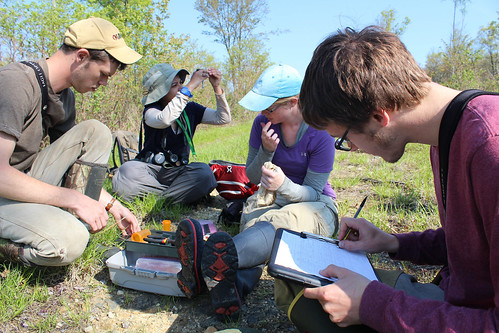
Indiana University of Pennsylvania students trap, band and release birds to help study their response to conservation activities. Location: Centre County, PA. Credit: Justin Fritscher, NRCS.
This year, they caught and released an adult male that that was originally banded in 2011. “That’s a long-lived bird, and it’s exciting to see them return to this habitat year after year,” he said.
The golden-winged warbler is a target species of Working Lands for Wildlife (WLFW) partnership. Since 2012, NRCS has worked with landowners and conservation partners to establish more than 13,000 acres of nesting habitat for the species.
Science Shows Sustainable Forestry Works
This field work by Larkin and his team shows that these conservation efforts are helping the species. They have found that more golden-winged warblers use habitat when early successional forests are clumped close to each other, and when some large trees are left scattered across a timber harvest.
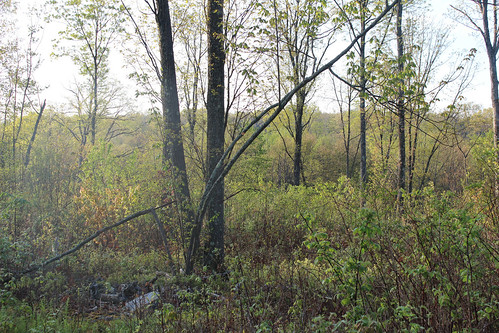
Clumps of trees among early successional forests provide optimal habitat for the golden-winged warbler. Credit: Justin Fritscher, NRCS.
Additionally, lands managed with sustainable forestry practices are home to an average of three golden-winged warbler territories for every 50 acres, and those sites provide habitat for more than 120 bird species – a third of which are suffering from significant population declines.
For example, Larkin’s team is finding that conservation work for golden-winged warbler greatly benefits the American woodcock, a popular game species that conducts its sky-dancing courtship as well as nests, raises brood and forage in young forests. Monitoring on private land sites enrolled in NRCS programs that target golden-winged warbler nesting habitat are revealing that nesting woodcock occupy 40 percent to 80 percent of the sites surveyed. Larkin and his research team predict these numbers will increase as the habitat to develop into a structurally diverse young forest.
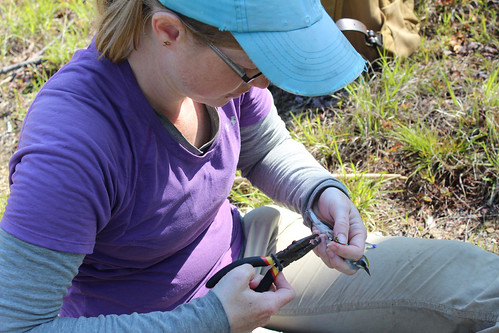
Renae Poole, who works with landowners to use NRCS conservation efforts to help the golden-winged warbler, bands a bird. Location: Centre County, PA. Credit: Justin Fritscher, NRCS.
More Information
Download a new NRCS report by Larkin and other scientists: Sustainably Managing Forests Creates Golden-winged Warbler Breeding Habitat. For more information on how wildlife are thriving on private lands, check out NRCS’ new magazine, Working Lands for Wildlife: A Partnership for Conservation Landscapes, Communities & Wildlife. Landowners interested in assistance to implement sustainable forestry practices should contact their local USDA service center.
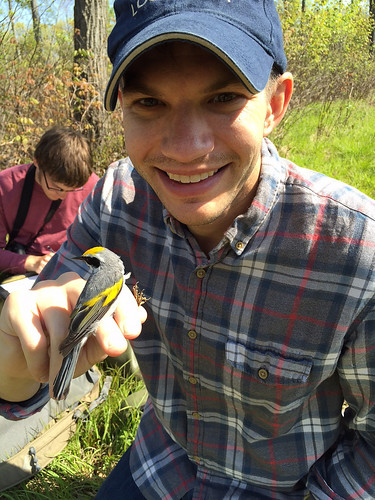
Justin Fritscher, NRCS public affairs specialist, with a newly banded golden-winged warbler.
No comments:
Post a Comment
Note: Only a member of this blog may post a comment.